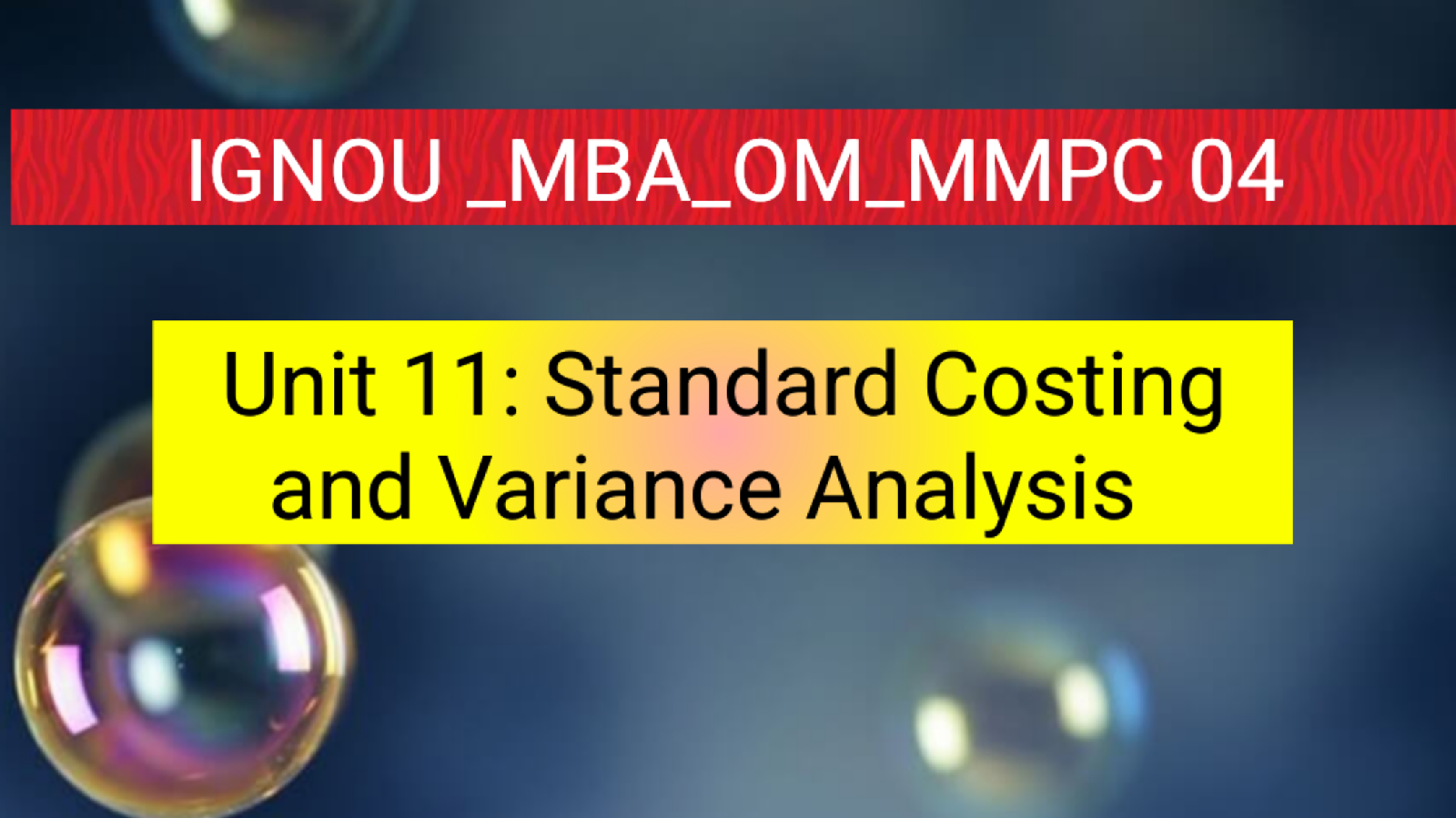Class 11: IGNOU MBA – MMPC 004: Accounting for Managers
Unit 11: Standard Costing and Variance Analysis
Overview of Unit 11:
Unit 11 introduces Standard Costing and its application in Variance Analysis. Standard costing involves setting predetermined costs for products or services, which are then compared to actual costs to identify variances. Variance analysis helps management evaluate performance, control costs, and make informed decisions.
Topics Covered in Unit 11:
11.1 Introduction to Standard Costing
Standard Costing is a technique used to estimate the expected cost of producing goods or services under normal conditions. These costs are referred to as "standard costs," and they serve as benchmarks against which actual costs are measured.
Key Objectives of Standard Costing:
- Cost Control: Identify and analyze differences between actual and standard costs.
- Performance Evaluation: Assess the efficiency of cost management.
- Budgeting: Facilitate the preparation of more accurate budgets by using standard costs.
- Decision-Making: Aid in pricing, production planning, and cost reduction strategies.
11.2 Setting Standard Costs
Standard costs are established based on historical data, engineering studies, or market analysis. They include:
- Direct Material Costs: The estimated cost of materials required for production.
- Direct Labor Costs: The estimated cost of labor, based on wage rates and time required for production.
- Overhead Costs: The estimated fixed and variable overhead costs allocated to production.
Types of Standards:
- Ideal Standards: Based on the assumption of perfect operating conditions. These are often unattainable in practice.
- Attainable Standards: Based on normal operating conditions, allowing for some inefficiencies.
11.3 Variance Analysis
Variance Analysis is the process of comparing actual costs with standard costs and identifying the reasons for any deviations (variances). This helps management take corrective actions to improve performance.
Types of Variances:
-
Material Variance:
- Material Price Variance (MPV): The difference between the actual price and the standard price of materials.
- Material Usage Variance (MUV): The difference between the actual quantity of materials used and the standard quantity.
Formula:
-
Labor Variance:
- Labor Rate Variance (LRV): The difference between the actual and standard wage rates.
- Labor Efficiency Variance (LEV): The difference between the actual hours worked and the standard hours allowed for actual production.
Formula:
-
Overhead Variance:
- Variable Overhead Variance: Differences in variable overhead costs.
- Fixed Overhead Variance: Differences in fixed overhead costs.
11.4 Interpretation of Variances
Variances are classified as:
- Favorable Variance: When actual costs are lower than standard costs, or actual revenue is higher than expected. This indicates efficiency.
- Unfavorable Variance: When actual costs exceed standard costs, or actual revenue falls below expectations. This indicates inefficiencies or higher costs.
Management should investigate significant variances to determine their causes, which could be due to:
- Price Fluctuations: Changes in the cost of materials or labor.
- Inefficiencies: Poor labor performance, wastage of materials, or machinery breakdowns.
- Inaccurate Standards: Unrealistic or outdated standards that do not reflect current operating conditions.
11.5 Benefits of Standard Costing and Variance Analysis
- Cost Control: Helps managers monitor costs closely and take corrective actions when variances occur.
- Improved Decision-Making: Provides detailed information on cost performance, leading to more informed decisions.
- Performance Evaluation: Assists in evaluating the efficiency of production processes and labor.
- Profitability Analysis: Helps in identifying areas of cost savings, leading to increased profitability.
11.6 Limitations of Standard Costing and Variance Analysis
- Time-Consuming: Setting standard costs and analyzing variances can be time-consuming and complex.
- Inflexible: Standard costs may become outdated due to market changes, inflation, or technological advancements.
- Focus on Cost Reduction: Excessive focus on reducing costs may compromise product quality or employee morale.
- Over-Emphasis on Variances: Management may focus too much on small variances instead of looking at the bigger picture.
Experiments and Real-Life Examples
- Experiment: Set up standard costs for a small business’s product (e.g., a bakery item). Compare actual production costs with the standard costs over a month and conduct variance analysis.
- Real-Life Example: A car manufacturing company finds that its labor efficiency variance is unfavorable due to workers spending more time on production than anticipated. By conducting variance analysis, the company identifies training needs and introduces automation to improve efficiency.
Assignment Questions
- Define standard costing and explain its importance in cost control.
- What are the different types of material variances? Provide formulas and explain how they are calculated.
- Discuss the advantages and limitations of variance analysis in performance evaluation.
Self-Study Questions
- What is the difference between favorable and unfavorable variances? Give examples of each.
- How can variance analysis help in improving the profitability of an organization?
- Discuss the factors that may lead to labor variances in a manufacturing setup.
Exam Questions
- Calculate the material price variance and material usage variance from the following data:
- Standard price: ₹20 per unit
- Actual price: ₹22 per unit
- Standard quantity: 1,000 units
- Actual quantity: 1,100 units
- What is labor efficiency variance? How is it calculated, and why is it important for management to track?
- Explain the role of standard costing in setting benchmarks for cost performance. What challenges do organizations face in maintaining accurate standard costs?
Conclusion
In this class, we delved into Standard Costing and its application in Variance Analysis, which are essential tools for cost control and performance evaluation. Standard costing involves setting expected costs, while variance analysis compares these with actual performance to identify areas of improvement. We explored different types of variances, their calculation, interpretation, and how they help managers make informed decisions. Despite its benefits, standard costing has limitations, such as the risk of outdated standards and an excessive focus on cost reduction. However, when applied effectively, it can lead to improved efficiency and profitability.





















